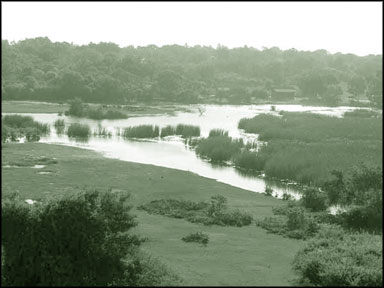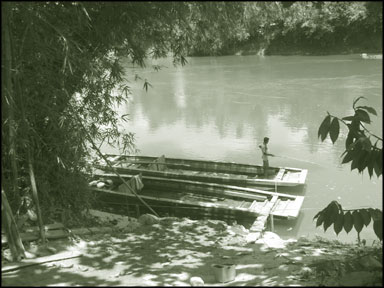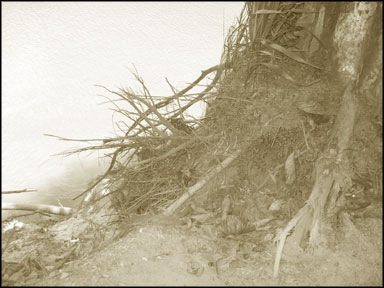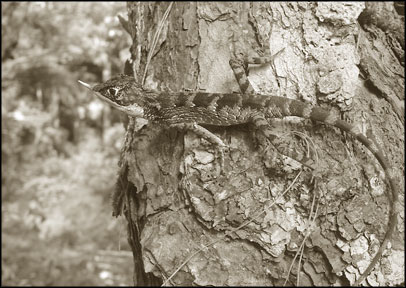Earth hope
Land of rich biodiversity
Gurupokuna - Kalametiya wetland
by Nilma Dole
 As Valentine's Day is celebrated, Mother Nature needs love and
attention too. Global warming continues to rise at an alarming rate in
the country. We have to think about how best to love her. The Kalametiya
wetland located in the southern region is also a biologically diverse
rainforest which has plenty of endemic species. As Valentine's Day is celebrated, Mother Nature needs love and
attention too. Global warming continues to rise at an alarming rate in
the country. We have to think about how best to love her. The Kalametiya
wetland located in the southern region is also a biologically diverse
rainforest which has plenty of endemic species.
Kalametiya is a quaint and quiet coastal wetland in the Hambantota
District. It is situated approximately halfway between the towns of
Tangalle and Hambantota. The popular Kalametiya Lagoon is a brackish
water body fringed by mangroves and salty marshes that is separated from
the sea by a narrow islet of beach. Kalametiya is also famous for its
bird life and was declared a Sanctuary in 1984. It has also been
declared a "Special Area Management" (SAM) site under the Coastal Zone
Management Plan (CZMP) in Sri Lanka.
Jetwing Eco-holidays CEO Gehan De Silva Wijeyeratne in his book
titled 'Sri Lanka National Parks and Reserves' says that Kalametiya is
an extensive area of wetland with brackish lagoons, mangrove swamps,
open grassy areas and pockets of scrub jungle. "It is an important site
for migrant waders and provides an important refuge (one of the few
remaining on the southern coastal strip) for the smaller mammals of Sri
Lanka", he points out.
 Many common wetland birds can be seen here like the Slatybreasted
Crake, Watercock and Black Bittern. During the northern winter, Glossy
Ibis may be present with thousands of waders and the Grey Mongoose and
Hanuman Langur are the mammals most likely to be seen. Many common wetland birds can be seen here like the Slatybreasted
Crake, Watercock and Black Bittern. During the northern winter, Glossy
Ibis may be present with thousands of waders and the Grey Mongoose and
Hanuman Langur are the mammals most likely to be seen.
The University of Ruhuna has also done extensive research on
Kalametiya and they have identified possible sources in changes of the
mangrove cover at Kalametiya. The research can not only be
environmentally beneficial but offer a livelihood for the people in the
area.
However, there have been reports of illegal deforestation as posted
by the Lakdasun Forum for Nature Conservation. Member Rahul says, "About
a year ago large parts of the shoreline of the 'lewaya' lagoon and
another dry lagoon was being destroyed by tractors, backhoes and dozers
without permits".
 He further adds, "There were rumours that a salt pan was supposed to
be developed but no environmental impact assessment was done.
Unfortunately, this problem has been badly damaging the environment
because dozers on the beach have already opened the way for sea access
to the lagoon which is cutting the beach 'watekeiya' that is crucial for
retaining the shoreline in order to make this water canal". He further adds, "There were rumours that a salt pan was supposed to
be developed but no environmental impact assessment was done.
Unfortunately, this problem has been badly damaging the environment
because dozers on the beach have already opened the way for sea access
to the lagoon which is cutting the beach 'watekeiya' that is crucial for
retaining the shoreline in order to make this water canal".
The IUCN (International Union for Conservation of Nature) has
catalogued Kalametiya as one of Sri Lanka's most important coastal
ecosystem because in their research document - A biodiversity status
profile of Lunama-Kalametiya Wetland Sanctuary - it has been reported
that a total of 283 species of vertebrates were recorded from the
Lunama-Kalametiya area, of which 14 species (5%) are endemic, while 17
species (6%) are nationally threatened.
The vertebrates comprise 35 species of fish, 13 species of
amphibians, 43 species of reptiles, 168 species of birds and 24 species
of mammals.
Deforestation is rampant in the area because the villagers have cut
down and burnt more than 50 ha of forest timber in the Kalametiya
sanctuary for their settlements, chena cultivation and shell mining.
This has displaced forest dwelling birds from their habitats. In
addition to this, ill-planned irrigation infrastructure, discharge of
agrochemicals into wetlands, unregulated animal husbandry, unauthorized
development activities, hunting and poaching of animals especially
turtles, accidents where animals have been killed on the
Matara-Hambantota main road and the spread of alien invasive species
have also become a problem in the area.
Overall, Kalametiya needs to be protected and if we don't do anything
about it now, this prized wetland will be lost forever.
Sand mining in river beds - a major threat to local waters
by Harshini PERERA
 Most of the rivers in South Asian region are polluted and most of the
time neglected except for the purpose they serve as resources. The
latest survey done by the United Nations indicates that around 750
million people sustained by the rivers in Asia will be affected due to
pollution. Sand mining in river beds and basins could be seen as a major
polluter. Many flora and fauna flourish besides rivers in Sri Lanka just
like in any other country. Most of the rivers in South Asian region are polluted and most of the
time neglected except for the purpose they serve as resources. The
latest survey done by the United Nations indicates that around 750
million people sustained by the rivers in Asia will be affected due to
pollution. Sand mining in river beds and basins could be seen as a major
polluter. Many flora and fauna flourish besides rivers in Sri Lanka just
like in any other country.
The Deputy Director of Mines explained to the Sunday Observer of
their sustained efforts at combating the situation. They have found out
that the sand mining is a threat to the entire biodiversity of Kelani
river, which had been the topic of environmentalists for long, should
take precedence. He, said sand mining could increase the saline water
intrusion, though it is a natural process which said to happen twice a
year.
"When sand miners in certain rivers, exceed the limit of the numberz
of cubes recommended by us, some of them, scoop the bed of the river to
the impermeable layer, so it causes the seepage of water. Thus the dry
down of water could keep many in thirst," he said. When the level of
water in the river naturally decreases it in turn increase the
temperature of the water. This could lead to many environmental issues
where the accustomed species in the river such as fish and plants will
get affected.
 The miners could see only the economic advantage of it whereas none
think of the harm it does to the environment. When mining is severe, the
miners not only damage the river bed by scooping sand but harm the flora
in the bank as well. The bank is more inhibited by fauna such as cane,
bamboo and mangroves. In fact, their sole existence get disturbed. The miners could see only the economic advantage of it whereas none
think of the harm it does to the environment. When mining is severe, the
miners not only damage the river bed by scooping sand but harm the flora
in the bank as well. The bank is more inhibited by fauna such as cane,
bamboo and mangroves. In fact, their sole existence get disturbed.
He said that "When salt water intrude above the normal distance, the
species in the beyond that limit could not survive in salt water. The
salt water can affect their natural way of living. Those species have
adjusted to the prevailing condition could no longer remain due to the
salty solution in water."
As a method to address the situation the Geological Survey and Mines
Bureau has carried out a survey in 2006 and learnt that there were over
200 miners engaged in three places namely, Hanwella, Kaduwela, Homagama
DS divisions. They have especially made it a policy for not to grant any
licence in Kelani river since 2006 but to those who had been already
engaged in mining at that time. This licence procedure includes some
policies to protect environment.
It says only a limited cubes of sand in limited days can be extracted
sand from the river. In the Kelani river a miner could get only 35 cubes
a day and they should do mining every other day. So, the disturbed river
receives a time to calm down, covering the damage it does to the river
bed.
The Mining Engineer, Kushana Gunesakara who is responsible for the
Gampaha division of the river explained that the impact on environment
is similar to the other side of the river. But they have made the access
points to the bank one meter, so that they have managed to save flora in
the river banks. Moreover, constant monitoring measures have taken place
and Police of certain areas are vigilant of the law breakers.
On Darwin anniversary:
Tourist limits to Galapagos, Antarctica?
Should the world celebrate the 200th anniversary today of the birth
of English naturalist Charles Darwin by working to limit the number of
tourists visiting the Galapagos Islands or Antarctica to protect their
spectacular wildlife?
 Would that help elephant seals like this one above on the Antarctic
Peninsula slumber more peacefully? And would it cause less disruption
for marine iguanas, below right, on Santa Cruz island in the Galapagos? Would that help elephant seals like this one above on the Antarctic
Peninsula slumber more peacefully? And would it cause less disruption
for marine iguanas, below right, on Santa Cruz island in the Galapagos?
The Galapagos in the Pacific Ocean gave Darwin insights into
evolution on his famed voyage around the world aboard The Beagle. Many
species - from mockingbirds to tortoises - differ from those on the
South American mainland.
And Antarctica, which wasn't even discovered when Darwin was born on
Feb. 12, 1809, is the world's last big wilderness.
About 39,000 tourists are likely to visit Antarctica this current
summer season, down from a record 46,000 a year ago and interrupting a
fast-rising trend in the past couple of decades, according to the
International Association of Antarctica Tour Operators Recession has hit
bookings of trips that cost thousands of dollars.
IAATO says the numbers are tiny - enough people to fill a football
stadium across a continent bigger than the United States.
But a group of environmentalists, the Antarctic and Southern Ocean
Coalition wants the numbers capped - it hasn't proposed an exact figure,
but says it shouldn't be too far above current levels.
Among nightmare scenarios for Antarctica, first sighted in 1820,
penguins might get bird flu. Or new seeds unwittingly brought by
tourists might thrive and displace lichens and mosses found nowhere else
on earth.
A big cruise liner might run aground, spilling oil and coating
beaches used by seals.
And the unique wildlife is of the Galapagos is similarly under threat
from people with both tourism and immigration from the South American
mainland.
See a BBC report here, for instance, saying that tourism rose to more
than 173,000 last year.
The United Nations in 2007 added the Galapagos to its list of world
heritage sites in danger. So should there be caps on visitors? If so,
how many?
If not, how do we protect these unique places?
Source: Reuters
Endangered:
Rhino horned lizard
|
Scientific name : Ceratophora stoddartii
English Name : Rhino-horned
lizard
Sinhala Name : Kagamuva
angkatussa
Status : Endangered, Endemic
|
 Ceratophora stoddartii belongs to family agamidae & genus Ceratophora
which is a relict genus. This genus contains five species, all of which
are endemic to Sri Lanka. Among them C. stoddartii is restricted to the
central massif (Horton Plains, Peak Wilderness, Pituruthalagala,
Kikiliyamana,) at cloud forest level. Ceratophora stoddartii belongs to family agamidae & genus Ceratophora
which is a relict genus. This genus contains five species, all of which
are endemic to Sri Lanka. Among them C. stoddartii is restricted to the
central massif (Horton Plains, Peak Wilderness, Pituruthalagala,
Kikiliyamana,) at cloud forest level.
C. stoddartii is a medium size lizard with thin body. It is known for
its unique feature of prominent conical shaped rostal appendage - a
'horn'-like that of a rhinoceros, which comprises a single scale. Mature
individual's dorsum and sides are dark brownish-green or yellow brown in
colour. C. stoddartii is found in sub arboreal microhabitats. According
to the 2007 Red List of Threatened Fauna and Flora of Sri Lanka the
Rhino-horned lizard is an endangered species. It is threatened due to
illegal encroachment for agricultural practices, pollution by
agrochemicals, habitat destruction, forest die-back, climatic change,
etc...
Reference
http://www.pdn.ac.lk/socs/zaup/reptiles/agamidae.html
Pethiyagoda, R and K. Manamendra-Arachchi (1998) A Revision of the
endemic Sri Lankan agamid Lizard Genus Ceratophora Gray, 1835, with
description of two new species. Journal of South Asian Natural History
Royal Asiatic Society (Ceylon). 3(1):1-50
- By Dilup Chandranimal
IUCN (The International Union for Nature Conservation)
Sri Lanka-Country Office
|


